Body, Mind and the Guitar
The following thoughts do not claim to be complete or exclusive, but they want to contribute to the discussion of bodily and mental stress of professional musicians in general, and of solo guitarists in particular. After a general introduction into the topic, we will give a brief historical outline of the various suggested postures of guitar playing in the past two centuries. Finally, we will present solutions to the problem by discussing various possibilities to improve body posture and mental state.
For people interested in learning more about the various methods which see body and mind generally not dualistic but as a unity (key word psycho motor activity) we have included a list of links below.
Perhaps one or the other colleague or music lover can make use of the experiences of this website´s author.
Excerpt of an article published by "Badische Neueste Nachrichten" (Author: Sylvia Pabst)
Many professional musicians perform in a way which ruins their health
Wide-spread denial of the risk
The production and performance of music is fun, but it can produce illness just as well. Quite often, professional violinists suffer from tendosynovitis or a "tennis elbow". A wide-spread handicap of long time orchestra musicians is the hearing problem, and singers can expect to eventually suffer from "singer nodules" spawning at their vocal chords.
According to Bernhard Richter, Assistant Medical Director for voice and speech therapy, more than 40.000 professional musicians in Germany are presently active in the field of classical music. Additionally, there are 20.000 students of music. 60 % of these students claim that their health has been impaired through their musical performances. Furthermore, annually 13 % of the active orchestra musicians resign early from their jobs because of occupational disability. "Stage fright is a big topic, too", says Bernhard Richter who is a physician as well as a graduate of musical studies. According to Richter, up to 50 % of concert musicians regularly take sedatives before performances to calm down.
Even more drastic are the statistics cited by Paul Ridder who is an orthopaedist and specialist for diseases of musicians in Freiburg. Surveys show that on a global scale 75 % of the orchestra musicians older than 40 are really physical wrecks. According to Ridder, this is the main reason for the fact that it is hard to find any elderly musicians in orchestras. 90 % of all string players have problems with their biting because the stress of the violin pressing against the chin is very high. From early on, this results in irregular positions of the teeth. All in all, the consequences include back and stomach problems and even cardiac arrhythmia. Guitarists who regularly use footrests are in danger of twisting their pelvis.
Body Posture and the Guitar
In recent years, the inner circles of professional guitar players luckily have resumed the discussion of the "right" posture when holding a guitar, but far too often the discussion focuses on a wrong perspective. It would be more appropriate to speak of a physiologically adequate posture in accordance with the motoric demands of the guitar. As early as in 1830, Fernando Sor who had a guitar school pointed out: "As I did not have a teacher, I had to think a lot before a rule of mine became a basic principle. Then I saw that all piano masters agree that one has to sit right before the point which marks the centre of the keyboard, i.e. in front of the middle of the horizontal line which both hands use. I found this rule to be convincing because all movements will be easy to execute when both arms keep the same distance from the body. Therefore I deduced that the middle of the string length, the 12th stop, should be opposite to my body."
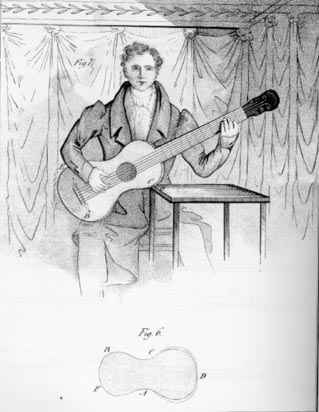
To adjust the middle of the instrument (where the guitar neck and the guitar body meet) to his own body centre, Fernando Sor used a table support
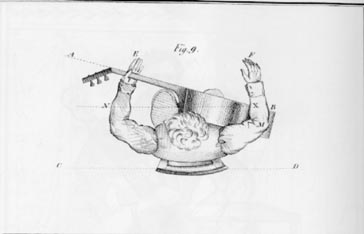
By bending the instrument (which stands centrally in front of the human body) forward and to the left, the shoulder line is straight.
Another master of the discipline from the same era was Dionisio Aguado who used extraordinary methods to realize the harmony of human body and instrument opposing each other at the middle.
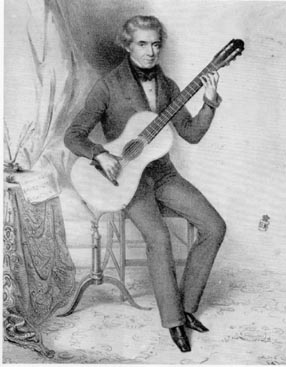
Dionisio Aguado and his tripod support
With the appearance of the bigger guitars of Antonio de Torres and a new touch and stroke technique (the touching finger executes the movement towards the next lower string and then rests there), and in the context of new aesthetics of timbre which demanded a movable right arm, guitarists such as Federico Cano, Miguel Llobet and especially the outstanding composer and teacher Francisco Tarrega preferred to use a footstool for the left foot.

Francisco Tarrega, playing posture
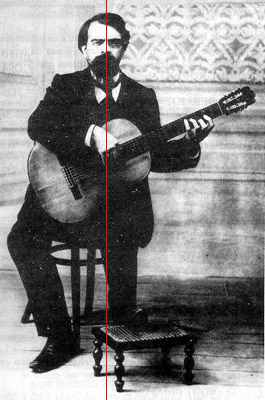
Francisco Tarrega with line through body centre
As Tarrego´s example and the following pictures of a student with a footstool demonstrate, the instrument rests on the raised left leg and the centre of the instrument shifts to the far left (movement out of the body centre). Negative consequences: a twisted and tensed pelvis area caused by the raised foot, the turn of the upper body to the left, and wrong position of the shoulders; finally a bad transmission of energy, as the direction of energy of the left hand is far beyond the body centre.
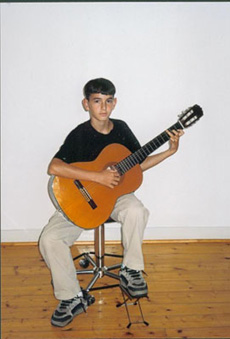
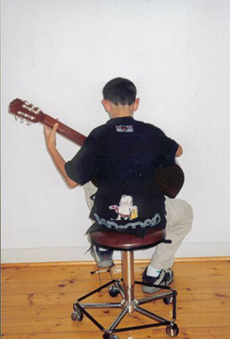
Student with foot support (front view and rear view)
Several colleagues have recognized the problem and offer various solutions. Whether pillow support, a wooden frame fastened by a sucker or plastic horns: All these suggestions mean doing away with the footstool under the left foot and locating it per sucker or attachment to the guitar. The advantage is that both legs stand upright on the floor which means a relaxed pelvis posture allowing a more relaxed breathing. The disadvantage is that the centre of the guitar is still located at the left side of the body, with all the negative consequences described above.
At the end of the Nineties, the guitarist and Alexander teacher Michael Trautmann came up with a new solution: He suggested to adjust the guitar in the tradition of the old Flamenco pose with the help of a long supporting stick on the left thigh to the upright and relaxed forward bent upper body of the player.
The technical solution of fastening the new supporting stick to the guitar came from Andrea Sciola, a guitarist who lives in Karlsruhe. He suggested using a triangular plate attached to the back of the guitar to fasten the supporting stick.

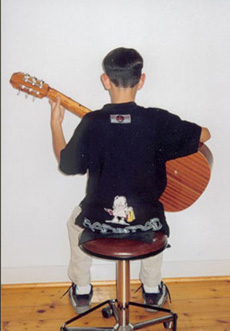
Student with guitar support (front view and rear view)
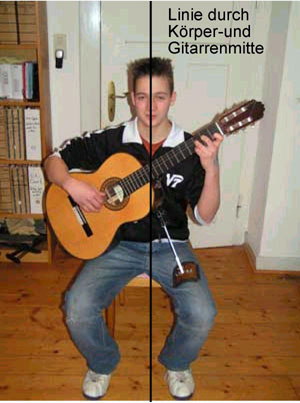
The advantage of this supporting stick: upright and relaxed posture of the whole body and, due to the centering of the instrument, easy execution of the movements of both arms and hands; effective transmission of energy because working out of the body centre. Due to the Perspex plate fastened at the back (which is equipped with spacing holders), the sounding board can swing freely and is not restricted by the upper part of the player´s body. This clearly improves the sound.
The depicted supports were produced by the author of this website for his own purposes.
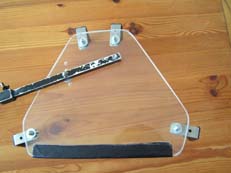
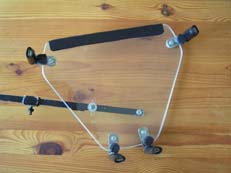
Front view and rear view of the Perspex plate

General view with overlay plate
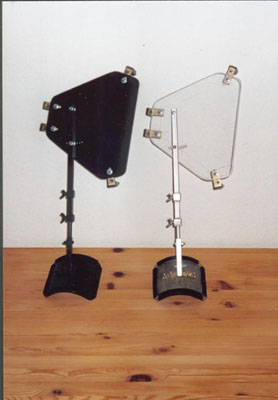
Support, varnished and raw
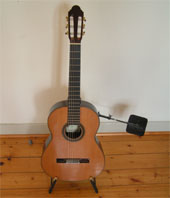

Guitar with support, front view and rear view
Mental Attitude and Music
Meanwhile it is a well-acknowledged fact that practicing music has a positive effect on the mental and general development of children and adults, regardless of their age. In this context we would like to mention the works of psychiatrist Manfred Spitzer "Lernen" ("Learning"), and "Musik im Kopf" ("Music inside the Head"), both published in 2002, as well as a book written by brain scientist Wolf Singer "Ein neues Menschenbild" ("A new Image of Humanity"). – On the other hand there is the fact that orchestra musicians, concert musicians and music teachers are exposed to enormous psychological stress during their working lives, caused by the pressure to perform and to function, by stage fright, and a tight time schedule. Teachers at music schools or private music teachers have to cope with a steadily rising number of obligatory teaching sessions and additional activities demanded by their jobs.
The negative consequences lie in a growing consumption of sedatives, in psychosomatic diseases such as back problems or tinnitus, and statistical evidence of a growing number of early retirements, connected with decreasing incomes and high medical costs.
Possible solutions: On one hand the affected musicians can try to actively influence their working conditions and personal environments; on the other hand they should reflect upon their personal attitudes toward their own selves. An early awareness of the problems may result in a preventive strategy focussing on a specific muscle training and a reasonable training of the cardiovascular system.
The self-reflection of the affected musician starts with the issue of a physiologically optimized collaboration of the human body and the instrument and will lead to think about the quality of personal daily practicing of music.
The excessive straining of sinews and muscles caused by many hours of monotonous repetition of difficult parts of a music piece can be reduced by mentally memorizing these parts without actually playing the instrument. This is a mentally strenuous process which stores different projections – depending on the individual learning abilities (the acoustic, mechanical or visual memory is concerned, or, quite often, a mixture of all three components). This method of exercising is an enormous support. It helps to become aware of basic mechanical and musical processes and to perform faultlessly in a concert situation characterized by stress.
To sophisticate this method means to train, refine and improve the ability of self-observation. In this context, the musician should focus his/her attention on his/her individual condition while playing and performing music (in order to be able to change it, if necessary) rather than direct it to the musical quality of his/her performance.
As most people cannot really cope with the problem of lifting their physiological and psychological barriers, it is useful to refer to very old methods and techniques of self-awareness and self-training. Apart from newer European methods of harmonizing body and mind (such as autogenic training, Alexander technique or Feldenkrais), there are ancient Asian techniques such as Yoga, Tai Chi, Qi Gong, Kyodo, and Aikido which have proved to be very effective. The latter techniques which have a history of several centuries regard the unity of body and mind as self-evident an insight which came much later in Western countries.
It would go beyond the scope of this website to give a complete and detailed description of these methods, even though they all try to achieve identical goals. We have therefore included several links to various home pages which deal with the topic of body posture and mental attitude.